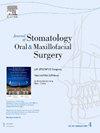使用 AUTOFIX 2.0® 套管加压螺钉系统进行下颌骨髁突骨折的切开复位和内固定术:术中CT扫描技术创新。
IF 1.8
3区 医学
Q2 DENTISTRY, ORAL SURGERY & MEDICINE
Journal of Stomatology Oral and Maxillofacial Surgery
Pub Date : 2024-10-31
DOI:10.1016/j.jormas.2024.102133
引用次数: 0
摘要
在颌面外科领域,髁突骨折一直是一个存在争议的问题,因为各种观点和文献中提出的治疗方法各不相同。目前的趋势是,只要出现移位或脱位,同时咬合条件不稳定,就应采取切开复位内固定术(ORIF)。基本的治疗目标是解剖固定和尽早恢复功能。然而,髁突骨折的口内固定术具有很大的风险,包括面神经损伤,而且在有限的区域内缩小和稳定骨折段也是一项挑战。我们在此介绍一种创新的髁状突头部骨折切开复位术。该技术包括使用两根 Kirschner 钢丝进行骨折复位和稳定,然后使用 AUTOFIX 2.0® 系统(美国卡拉马祖,史赛克公司)的两根插管无头加压螺钉进行骨合成。这项新技术与术中 CT 扫描相结合,确保了对脱位关节段进行令人满意的缩小和稳定,从而使髁状突恢复到生理正常位置。本文章由计算机程序翻译,如有差异,请以英文原文为准。
Open reduction and internal fixation of mandibular condyle fractures using AUTOFIX 2.0® cannulated compression screw system: A technical innovation with intraoperative CT-scan
Condylar process fractures remain a matter of ongoing controversy in maxillofacial surgery because of variety of opinions and proposed treatment modalities offered in the literature. The trend is toward open reduction and internal fixation (ORIF) whenever there is displacement or dislocation combined with unstable occlusal conditions. The fundamental treatment goals are anatomical fixation and early return to function. However, ORIF of a fractured condyle carries significant risks, including facial nerve damage, and presents challenges in reducing and stabilizing the fractured segment in an area of limited access. We present here an innovative technique for ORIF of condylar head fractures. It consists in fracture reduction and stabilization with two Kirschner wires followed by osteosynthesis with two cannulated headless compression screws using the AUTOFIX 2.0® system (Stryker, Kalamazoo, USA). This new technique, combined with intraoperative CT scan, ensures satisfactory reduction and stabilization of the dislocated joint segment, thereby restoring the condyle to its physiologically normal position.
求助全文
通过发布文献求助,成功后即可免费获取论文全文。
去求助
来源期刊

Journal of Stomatology Oral and Maxillofacial Surgery
Surgery, Dentistry, Oral Surgery and Medicine, Otorhinolaryngology and Facial Plastic Surgery
CiteScore
2.30
自引率
9.10%
发文量
0
审稿时长
23 days
 求助内容:
求助内容: 应助结果提醒方式:
应助结果提醒方式:


